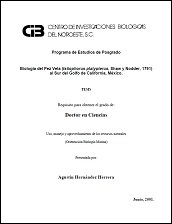LAS POBLACIONES DE ALMEJA CATARINA Argopecten ventricosus EN EL CENTRO DE ACTIVIDAD BIOLÓGICA DE BAHÍA MAGDALENA, MÉXICO
Author
Alfonso Nivardo Maeda Martínez
MARIA TERESA SICARD GONZALEZ
LILIANA CARVALHO SAUCEDO
SALVADOR EMILIO LLUCH COTA
Daniel Bernardo Lluch Cota
Metadata
Show full item recordAbstract
"En el presente trabajo se analizó el estado actual de las poblaciones de almeja catarina (Argopecten ventricosus) en el Centro de Actividad Biológica (BAC) de Bahía Magdalena, a través de la actualización, con datos de los 1990s, de un modelo planteado en 1993, que explica la formación de bancos de almeja catarina basándose en las fluctuaciones térmicas, la pesquería, el reclutamiento de juveniles, la presencia y/o abundancia de langostilla (Pleuroncodes planipes) y la presencia de pastizales marinos. Los resultados indican que el modelo es consistente con sus postulados. Adicionalmente se encontró que el cultivo de la almeja catarina en el BAC, contribuye a la formación de bancos someros de almeja catarina, siempre y cuando la temperatura permita el desarrollo de pastizales donde las larvas se fijen y obtengan el refugio necesario contra los depredadores." "In the present work, the validity of the model to explain the formation of catarina scallop populations in the Biological Activity Center of Bahia Magdalena (BAC) published in 1993, was assessed with data from the last decade. Temperature fluctuations, fishery landings, spat recruitment, and the ocurrence of red crab Pleuroncodes planipes and sea grass beds in the bay during the 90’s, were considered for the analysis. Results indicate that the model is consistent with its postulates. Aditionally it was found that that the catarina scallop aquaculture in the BAC, contributes to the formation of shallow scallop stocks during prolonged cold events, since the large sea grass beds serve as primary substrate for larval recruitment and shelter against predators for the resulting spat and adult scallops."
Collections
Related items
Showing items related by title, author, creator and subject.
-
PROMOCIÓN DEL PERIFITON PARA EL CULTIVO DE CAMARÓN BLANCO: HACIA UNA ACUICULTURA ECOLÓGICA
DOMENICO VOLTOLINA LOBINA; JUAN MANUEL AUDELO NARANJO; MARIA DEL ROSARIO PACHECO MARGES -
Suelo y Erosión
YOLANDA LOURDES MAYA DELGADO


